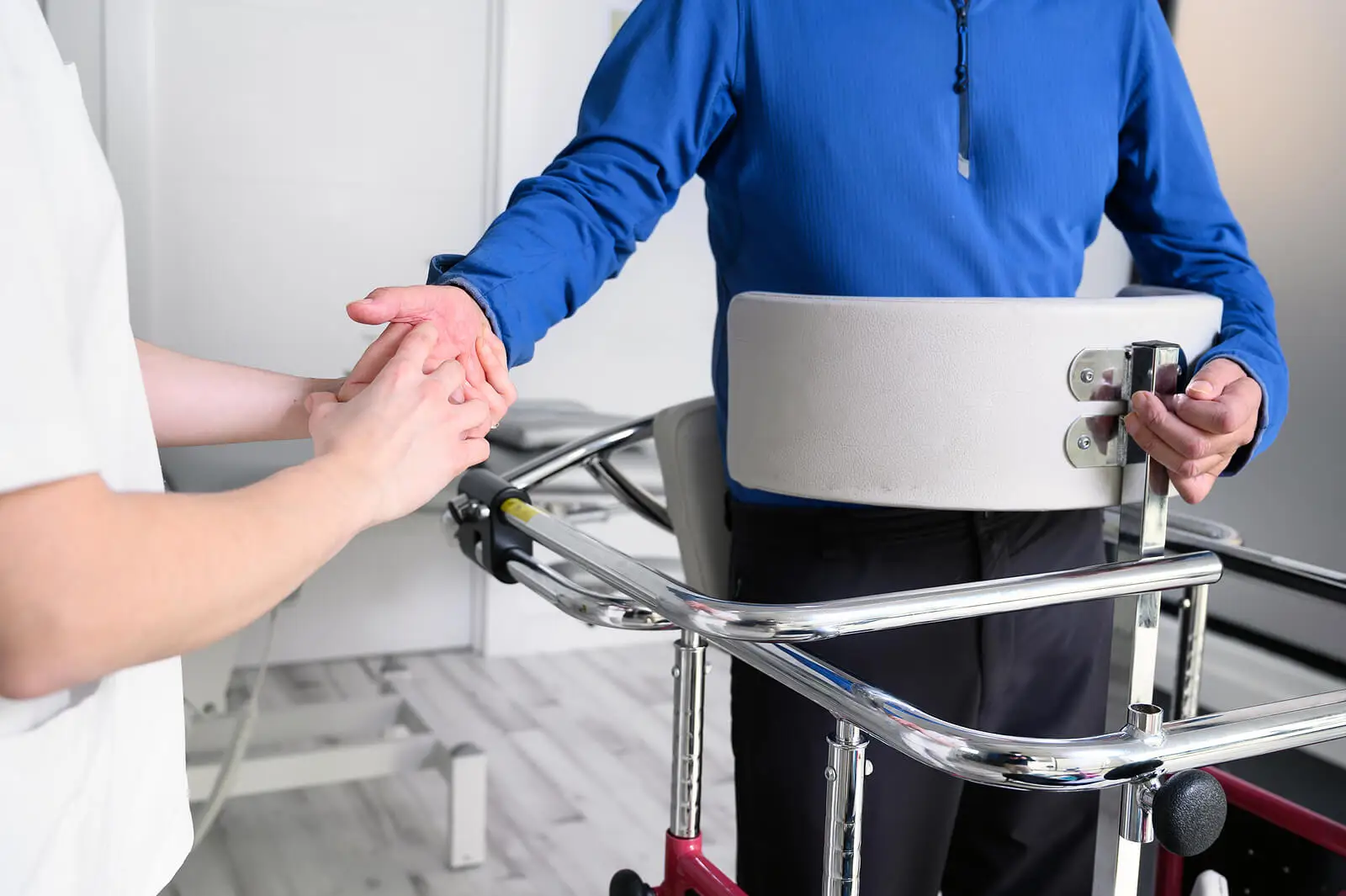Leg Weakness: 9 Possible Causes


Reviewed and approved by the nurse Leidy Mora Molina
Intense physical exercise and circulation problems are some of the most common causes of leg weakness. However, this symptom can also be the result of serious neurological, cardiovascular, and musculoskeletal conditions. Here we tell you more.
When we talk about weakness, we refer to a decrease or partial loss of strength. In this sense, people with leg weakness are not able to move the muscles of the lower limbs, even when they try.
This term is often confused with fatigue, tiredness, and drowsiness.
The most common causes of leg weakness
Leg weakness hinders the performance of daily activities and hinders the mobility of those affected. It’s also one of the main reasons for falls and injuries in older adults. Among the most common causes are the following.
1. High-intensity physical activity
High-level physical exercise and overtraining are frequent causes of weakness in the legs, especially in people with little experience. In general, this symptom appears after training sessions and may be accompanied by muscle tremors.
Similarly, it’s common for weakness to reappear after a couple of days, associated with pain and muscle tension. In this case, it’s the result of the recovery process of the distended and worn tissue. In most cases, people improve spontaneously after 2 to 4 days.

We think you may also enjoy reading this article: The Benefits of Eccentric Leg Training and 6 Recommended Exercises
2. Peripheral arterial disease
This is a common circulatory problem that affects 15-20% of people over 70 years of age, according to studies. This disease results from a decrease in the caliber of the arteries with reduced blood flow to the extremities.
Muscle weakness and numbness in the legs are typical manifestations of this condition. Similarly, patients often manifest pain in the thighs or calves after walking or climbing stairs.
Other symptoms include the following:
- A cold sensation in the legs
- Color changes in the lower limbs
- Weak pulse in the legs or feet
- Shiny skin
Atherosclerosis is the main culprit of peripheral arterial disease. A physical examination, ankle-brachial index, a Doppler ultrasound, and angiography are the methods used for diagnosis. Treatment is aimed at relieving symptoms and halting progression.
3. Venous insufficiency
This is a vascular disorder characterized by difficulty in the return of blood from the legs to the heart due to incompetent valves in the veins. Over time, the veins become distended and retain blood in the lower limbs, especially when standing.
This condition is 5 times more common in women than in men, according to research. Skin changes such as swelling, dryness, redness, varicose veins, and sores that are slow to close are usually seen.
Weakness in the legs, cramping, itching, and pain at rest are among the typical symptoms of the condition. Doppler ultrasound is the diagnostic test of choice. The therapeutic plan seeks to improve venous blood mobilization and institute healthy habits.
4. Peripheral neuropathy
Peripheral neuropathy is a neurological condition caused by damage to the nerve pathways responsible for the transmission of information between the brain and the rest of the body.
In most cases, people manifest a stabbing or burning pain in the legs or hands. Similarly, it’s possible to find the following symptoms:
- Numbness and tingling
- Muscle weakness
- Hypersensitivity to touch
- Coordination and gait problems
Likewise, the main causes of this syndrome are traumatic injuries, diabetes, infections, and exposure to toxic substances. Treatment includes the use of medications to reduce symptoms, nerve stimulation, physical therapy, and surgery.
5. A herniated disc
A herniated disc is a protrusion of the nucleus pulposus through a weakened part of the intervertebral discs, located in the spine. This condition can occur at any level of the back, being more frequent in the lumbar area.
Studies estimate that disc herniations produce 2% of the cases of dorsolumbar pain in people between 30 and 50 years old. The sensation of weakness in the legs is a manifestation of lumbar hernias. The weakness usually promotes falls and stumbling and makes it difficult to get out of bed.
Tingling, burning, and pain in the buttocks and lower back are also common. The treatment plan includes the use of drugs, physical therapy, and surgical correction, depending on severity.
6. Cerebral vascular disease (CVD)
CVD is a disorder characterized by a sudden loss of neurological function resulting from a disturbance in blood flow to the brain due to ischemia or hemorrhage, as defined by studies. In most people, it causes weakness on one side of the body and altered sensation.
Affected patients may also experience slurred speech, confusion, blurred vision, dizziness, and impaired balance. This condition requires emergency medical management, so it’s crucial to recognize it early and seek help as soon as possible.
7. Guillain-Barré Syndrome
This is an autoimmune disorder in which the body attacks the nerve pathways. Some research states that this syndrome presents itself with symmetrical, progressive, ascending muscle weakness. In addition, it’s often accompanied by decreased or abolished reflexes.
Currently, there’s no definitive cure for this condition. However, plasmapheresis and administration of immunoglobulins can alleviate symptoms and reduce progression.
8. Multiple sclerosis (MS)
Multiple sclerosis is a chronic inflammatory disease of autoimmune origin in which there is the destruction of the nerve fibers of the central nervous system. It affects the brain, brainstem, spinal cord, and cranial nerves, with an affinity for the optic nerve.
This disorder can debut with different symptoms, depending on the anatomical area affected. The most common manifestations include the following:
- Muscle weakness and fatigue
- Cognitive impairment
- Memory loss
- Gait disturbances
- Tremors and muscle spasms
Treatment of MS is based on the use of corticosteroids during disease flares. Similarly, immunomodulators and physiotherapy can be used to improve long-term symptomatology.

Like this article? You may also like to read: Hulk Hogan “Can’t Feel His Legs”: What Happened to the WWE Legend?
9. Compression of the spinal cord
Occasionally, certain traumas and disorders produce compression of the spinal cord structures. Hematomas, abscesses, and tumors are some of the main causes of this condition. The person manifests back pain, tingling, and weakness in the legs.
Studies estimate that spinal cord compression occurs in 5% of cancer patients and even maintains an incidence of 10% in people with spinal metastases. The most commonly associated cancers include multiple myeloma, lymphoma, and lung cancer.
Leg weakness: A symptom that shouldn’t be taken lightly
Leg weakness is a manifestation present in a vast number of disorders and diseases. It’s associated with physical exercise and poor circulation. However, it also warns of several underlying neurological and vascular conditions that require attention as soon as possible.
Don’t hesitate to consult a specialist if you notice a rapid progression of weakness or persistence of weakness. In addition, the presence of pain increases the need for professional attention.
All cited sources were thoroughly reviewed by our team to ensure their quality, reliability, currency, and validity. The bibliography of this article was considered reliable and of academic or scientific accuracy.
- American Association of Neurological Surgeons (2024) Herniated Disc. Consultado el 14 de agosto de 2024. https://www.aans.org/patients/conditions-treatments/herniated-disc/
- American Endovascular (s.f) Leg weakness. Consultado el 05 de agosto de 2024. https://americanendovascular.com/pad-symptoms/leg-weakness/
- Davis, D., Maini, K., Taqi, M., Vasudevan, A. (2024) Sciática. National library of Medicine. StatPearls. Consultado el 14 de agosto de 2024. https://www.ncbi.nlm.nih.gov/books/NBK507908/
- González R., Andínez, D. (2016) Epidemiología, etiología y clasificación de la enfermedad vascular cerebral. Archivos de Medicina;16 (2): 495-507. https://www.redalyc.org/journal/2738/273849945026/html/#:~
- National Health Services NHS (2022). Peripheral neuropathy. Consultado el 14 de agosto de 2024. https://www.nhs.uk/conditions/peripheral-neuropathy/
- National Institute of Neurological Disorders and Stroke NIH. (s.f) Amyotrophic Lateral Sclerosis (ALS). Consultado el día 04 de agosto de 2024. https://www.ninds.nih.gov/health-information/disorders/amyotrophic-lateral-sclerosis-als
- Singleton, J., Hefner, M. (2023). Spinal Cord Compression. National library of Medicine. StatPearls. Consultado el 14 de agosto de 2024. https://www.ncbi.nlm.nih.gov/books/NBK557604/
- Sociedad Española de Farmacia Comunitaria (2017) Guía práctica para prevenir y tratar el Síndrome de piernas cansadas. https://www.sefac.org/sindrome-de-piernas-cansadas
- Organización Mundial de la Salud (2023) Síndrome de Guillain–Barré. Consultado el 14 de agosto de 2024. https://www.who.int/es/news-room/fact-sheets/detail/guillain-barr%C3%A9-syndrome
This text is provided for informational purposes only and does not replace consultation with a professional. If in doubt, consult your specialist.








